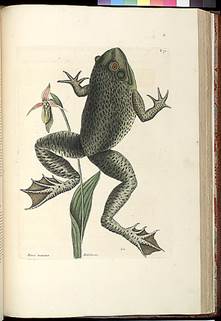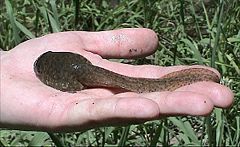“He ketched a frog one day, and took him home, and said he cal’lated to educate him; and so he never done nothing for three months but set in his back yard and learn that frog to jump.” Simon Wheeler inThe Celebrated Jumping Frog of Calaveras County. Mark Twain.
his is North America’s largest frog averaging between 3.5 – 6 in. in length and 0.2 – 6.2 oz. but large males have been recorded to weigh up to 1.8 lbs. with a length of up to 8 in. (nose to vent – so stretched-out legs not included). The bullfrog is native to eastern North America along the Atlantic Coast and as far west as Oklahoma and Kansas. It has been, unfortunately, introduced to a number of western states including Arizona, Utah, Nevada, California, Oregon, Washington, and Hawaii. They are typically found along the shore of lakes, ponds, and swamps amongst aquatic vegetation.
Rana – Latin for frog and catesbeiana honoring the English naturalist Mark Catesby, who published the Natural History of Carolina, Florida and the Bahama Islands, the first published account of the flora and fauna of North America (in series between 1729 – 1747). Interestingly, Carolus Linnaeus included much of Catesby’s information in Linnaeus’s 10th edition of Systema Naturae (1758).

Wide introductions are unfortunate because this frog will eat just about anything it can catch including mice and voles, amphibians and reptiles, smaller bullfrogs, and birds, including ducklings. It is responsible for decline of local amphibians wherever it is introduced. In Washington, the spotted frog is largely extirpated from the Puget Sound region, save a few isolated pockets, due to habitat modification and the introduction of the bullfrog, which will eat this smaller spotted frog as if munching on movie popcorn. Bullfrogs are quite aggressive feeders and will capture prey by stalking it and throwing out their sticky tongue (attached to front of mouth), pursing prey in water or on land, and capturing prey by biting it and then stuffing it in its mouth with its front legs. Quite impressive really: http://www.bing.com/videos/search?q=bullfrog&view=detail&mid=BAA3C310F4C2818C3751BAA3C310F4C2818C3751&FORM=VIRE1
Besides their distinctive size, bull frogs can be identified by their olive-green back with a mottling or banding of gray-brown. They have a large tympanum, or ear drum, behind their eye that helps distinguish them from the smaller green frog. The front legs are short and stocky and are not webbed, as are the strong hind feet. Males are larger than females and have a yellow throat. Males also have tympani larger than their eyes while in females they are about the same size as the eyes. Breeding occurs in the warm weather and can last from late May into early July. Males have a loud, baritone, and distinctive call that sounds like they are saying “jug-o-rum”. http://www.bing.com/videos/search?q=bullfrog+call&view=detail&mid=6E9412872A08D2784C7A6E9412872A08D2784C7A&FORM=VIRE6
Males will aggregate into groups that are called choruses and this behavior has been compared to other vertebrates, such as sage grouse, where the males group together to call and display to attract females. In bullfrogs these groups are dynamic and can form, dissolve, and they regroup with other members nearby. Further, it is thought that choruses develop when densities of males are high and territory competition would be fierce. When male populations are less dense, males tend to not form choruses and defend individual territories – in this case females will choose mates based on the quality of the territory. When choruses are formed females appear to choose mates based on other cues such as positon in the chorus and display attributes. Who knew?
Males will clasp a willing female, who lays her eggs while the male fertilizes them. About 20,000 eggs are laid in shallow water and form a thin, floating sheet. Embryo development is best in water between 75 and 86 deg F and they will hatch in 3-5 days. Tadpoles will eat plankton, bacteria, pollen grains, and protozoa. The time for a tadpole to metamorphose into a frog can range from a few months in the southern portion of its range to up to 3 years in the colder northern range extent. Bullfrogs are thought to live 8-10 years in the wild but one captive frog lived to 16 years.

It seems that the majority of my childhood summers were occupied by catching frogs. In my small NJ town there were a number of ponds, the favorite for knowing frog hunters were the series of ponds adjacent to what we called the tar factory, some long abandoned tar something-or-other factory with now remnant foundations scattered about.
Pickerel, green, leopard, and of course the largest quarry, the bullfrog, were abundant. For me it was pure catch-and-release, but for others, like the wild Dominacus brothers, it was not. All summer they kept a 50 gallon drum in their back yard, only blocks away from the tar factory ponds, and stashed any frog they caught in it, culling as necessary, tossing the dead ones over the fence. Come the end of summer the survivalists were emptied in the creek behind the house. I thought it was strange even then.
There was a resident bullfrog that was exceptionally large and within our small circle of frogers was known as Queenie. Queenie was extremely vigilant and agile. With just the slightest underfoot dry leaf snap or vegetation movement she would dive into the middle of the pond. Not only interested in vertebrate capture I had a butterfly net at home that I decided I needed to facilitate the capture of this elusive treasure. A
fter sitting still for what seemed like hours and tolerating about 50 mosquito bites along the bank of the small pond, Queenie surfaced nearby and I made the most of my chance. But despite my cat-like, 10-year-old reflexes, I only partially netted her and she forcefully leapt, pulling the net out of my hand. So much for glory.
I waded into the pond muck to retrieve my net, which, really, on the scale of frog-capture-ethics, would probably be looked upon as cheating in my circle of friends. Quick of hand garnered respect and was the only noble way to frog catch.
